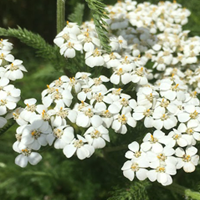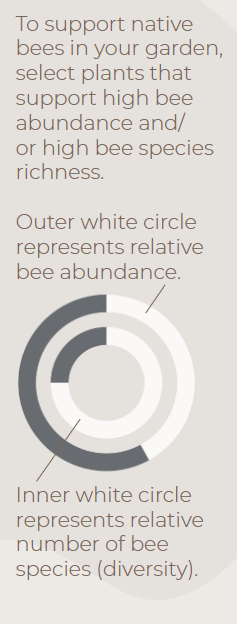The Garden Ecology Lab’s Pollinator Plant PR Campaign Presents….. Yarrow!
The Garden Ecology Lab is releasing a series of plant profiles of the top 10 Oregon native plants for pollinators, based on Aaron Anderson’s 2017-2019 field trials of 23 Oregon native plants. We will feature one plant per week for 10 weeks, this is week 1! Profiles will include photos, planting information, and will highlight common pollinators of each plant.

Plant Facts
- Scientific Name: Achillea millefolium
- Life Cycle: Perennial
- Growth Habit: Upright, spreading
- Bloom Duration: June – October
- Hardiness Zone: 3-7
- Special Traits: Drought tolerant, deer resistant
- When to plant: Starts can be planted in the spring or fall.
Pollinator Facts
- Yarrow provides both nectar and pollen to its insect visitors.
- Yarrow was found to be associated with two species of Andrena in Aaron’s research (Andrena cerasifolii, A. candida).
- Andrena is a genus of early summer mining bees!
- Other common visitors to yarrow include sweat bees, nomad bees, and butterflies!
- Yarrow inflorescences provide a great “landing pad” for pollinators- they can rest directly on the plant while they forage.

Yarrow’s Native Range in Oregon

In Oregon, we have our own native variety of yarrow: Achillea millefolium var. occidentalis. Western yarrow's native range covers the entire state of Oregon. Map acquired from USDA Plants Database. Copyright 2014 © ESRI
Yarrow as a pollinator plant
Yarrow is a ubiquitous North American native plant: its range extends from Alaska to Florida and every state and province in between! Though it commonly appears on pollinator planting lists, many people are not convinced that it’s a great bee plant, because it is not typically buzzing with activity like we may see on Goldenrod or Douglas Aster. Instead of hosting an abundance of visitors, yarrow supports a high diversity of insect visitors.


Infographics developed by LeAnn Locher, Aaron Anderson, and Gail Langellotto.
Abundance and Diversity Calculations. Bee abundance was calculated using estimated marginal means of bee visitation to each of our study plants from 5-minute observations conducted from Aaron's 2017-2019 field seasons. Estimated marginal means (EM Means) were assigned categorical values and averaged across years to yield the following categories: 0% = Very Low =EM mean below 0.49; 25% = Low = EM mean of 0.50 to 0.99; 50% = Moderate = EM mean of 1 to 1.49; 75% = High = EM mean of 1.50 to 1.99; and 100% = Very high = EM mean above 2.0. Bee diversity was based on the total sum of species collected on each of our study plants from 2017 to 2019. A Chao 2 Estimator was used to estimate total expected species richness for each plant; Chao 2 estimates were then used to create categorical values, as follows: 0% = Very Low = 9.99 or lower; 25% = Low = 10 to 14.99; 50% = Moderate = 15 to 19.99; 75% = High = 20 to 24.99; 100% = Very high = 25 or higher.
Although yarrow doesn’t buzz with activity like some pollinator plants, it’s certainly not a flower to ignore! Yarrow is a hardy and low maintenance perennial that establishes and spreads readily in gardens. It’s a beautiful cut flower and can also be dried to include in longer lasting floral arrangements; its foliage that maintains its aromatic scent even after drying. Yarrow is additionally a wonderful plant medicine that has been used for centuries.
Did you know?
Yarrow has naturally-occurring pink variants! It can vary from pale pink (left), to deeply magenta (right). These plants were started from seeds collected from wild populations of yarrow, so we can be certain it is indeed a natural variation, rather than a true hybrid or cultivar! Another fun fact: "millefolium" translates to "thousand-leaved", which is a reference to its dissected leaves!
Photos from the field
Tune in next week for the next edition of our Pollinator Plant PR Campaign.








This is great. I am looking forward to the weekly postings. I wonder if there’s a way to save the information as a pdf?
Hi Bob!
If you ‘print as PDF’, you should be able to generate (and then save) this information as a PDF. Alternatively, we are working to publish all of this information as an Extension publication (hopefully, within the next month or two).
You changed my mind about growing yarrow. I hadn’t seen many bees on yarrow and wondered why it was significant. Now I know and will plant it. . Very encouraging photos! I will be very glad to get this info as a PDF.
This comment made my day, Sara!! Thank you so much for taking the time to share.
Love this, especially for praising the attributes of an unassuming and easily overlooked native. I too will look for more to plant. Thank you!
I’m hoping to get these as a weekly email that I can share with my gardening neighbors
Hi Mary,
On our homepage (https://blogs.oregonstate.edu/gardenecologylab/) there’s an option to subscribe to the blog, near the top right hand corner of the page (below the large photo, and the list of subpages). If you subscribe, you will get an email every time a new blog post is published. Right now, our group is on week 2 of 10 . . . so there are eight more posts to go. You can unsubscribe, at any time, if you no longer want to get the notifications of our posts.
Love Yarrow! We have a good bit naturally. Look forward to these posts. Would love an Eastern Oregon shrub series! (unless there has been one already).
Hi Elise. You might be interested in this publication from OSU Extension: “Selecting Native Plants for Home Landscapes in Central Oregon”.
https://catalog.extension.oregonstate.edu/ec1623/html
My own lab group doesn’t currently conduct plant-pollinator research in Central or Eastern Oregon. But, Sandy DeBano’s lab group does. Here is a recent publication from her Ph.D. student, Scott Mitchell.
https://onlinelibrary.wiley.com/doi/abs/10.1111/rec.13525
I will ask my team (and Scott and Sandy) if they would like to do a series on the shrubs that Scott found to be highly attractive to native bees. Scott and Sandy might already be planning to do this type of series, and I don’t want to steal their thunder.
One caveat about yarrow: if you have sandy dry soil, it can easily take over. I’ve used it in test plots where it become dominant and very difficult to get rid of. If your soil is harder and more silty, this is a good choice for dry areas.